This article is about the conservation treatment of a Warren Thompson stereo-daguerreotype belonging to a private collector.
The label on the back of the daguerreotype package indicates its author: “W. Thompson, rue de Choiseul, 22”. Warren Thompson was an American photographer who had a studio in rue de Choiseul, Paris, France, from 1853 to 1859.

Before treatment – recto 
Before treatment – verso
What is a daguerreotype?
A daguerreotype is a photograph on metal. It is composed of a copper plate, covered by a silver layer polished to a mirror finish. The white image forming particles (silver-mercury amalgam) are on the surface of the silver. Depending of the light and view angle, a daguerreotype can appear as a negative or a positive image.
Daguerreotypes were invented by Jacques Louis Mandé Daguerre (1787-1851), after his joint research work with Nicéphore Niepce (1765-1833) in the 1830s. They were presented to the public in 1839.
Unlike photographic prints, daguerreotypes are unique images. To get another image you would have to take another photograph of the subject or the daguerreotype itself.
What does “stereo” mean?
Stereo, short for stereoscopy, is a method used to reproduce a 3D image impression from two 2D images. It is based on the principle of binocular vision: 3D is created in the human brain by combining the perception generated from your two eyes.
This theory was presented at the Royal Society by Charles Wheatstone (1802-1875) in 1838 along with the first “stereoscope”, an instrument that allowed the viewer to recombine two very similar 2D images to obtain the impression of 3D.
Once the daguerreotype was presented to the world and used by early photographers, Wheatstone went directly to early daguerreotypist to create the first stereo-daguerreotypes.
Condition of the daguerreotype
Upon arrival at CLC’s conservation lab
The client brought this Warren Thompson stereo-daguerreotype to our conservation lab because it had fallen on the ground, resulting in the cover glass breaking, with some glass fragments loose against the daguerreotypes’ surface.
The first examination of the object showed that, apart from the broken glass, the package was in good condition; however, various observations indicated that the daguerreotype package had previously been opened.
- The paper sealing tape seemed to be in very good condition and made of thicker paper than the ones usually encountered on daguerreotypes from this period.
- Furthermore, the back of the package showed three overlapping layers of black paper. It was observed that the bottom paper layer was partially covered by a second paper layer, which was also partially covered by the sealing tape. This suggests that perhaps the current sealing tape had been applied on top of the original sealing tape and backing paper.
To work on the broken glass, it was necessary to open the package to access both sides of the cover glass and remove the loose fragments.
After opening the package
After carefully cutting the sealing tape, the inside of the daguerreotype package was accessible.
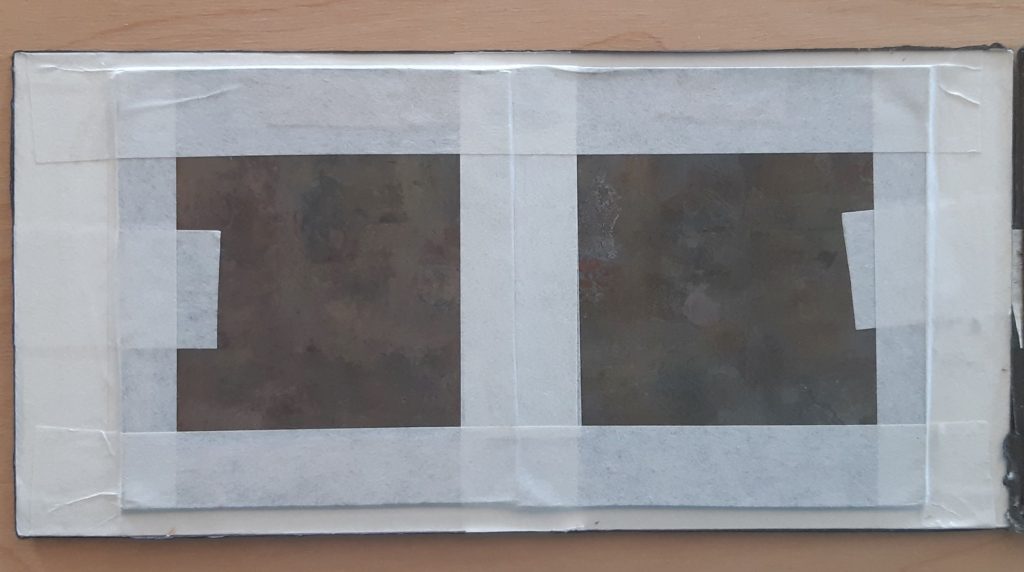
During treatment – inside of the package – daguerrotype maintaining system 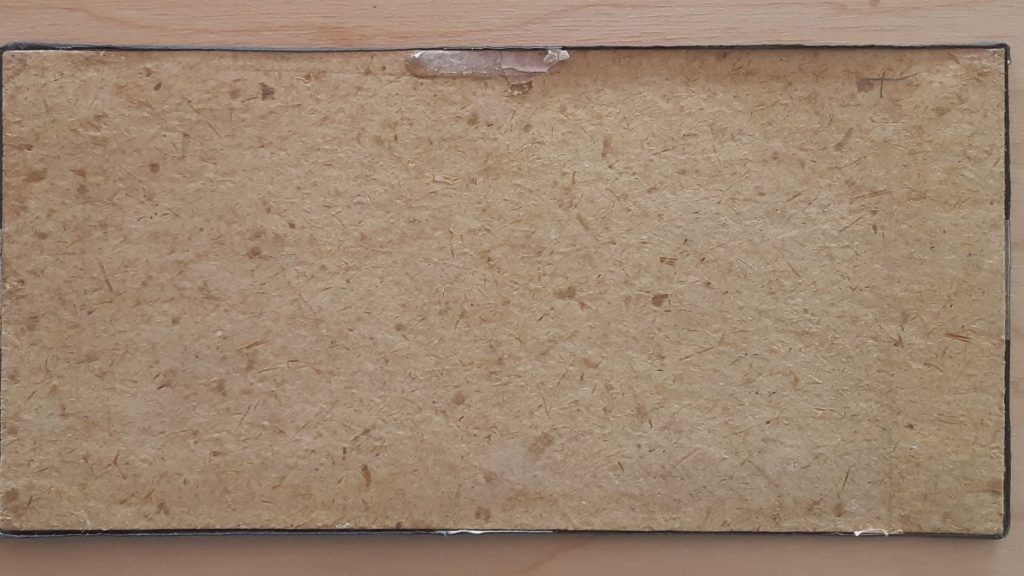
During treatment – inside of the package – backing board
The package was composed of the following elements:
- a reverse-painted cover glass
- a system to maintain the daguerreotype plates in the package: a white matboard and tape, placed directly in contact with the front and back of the daguerreotype plates.
- a wood-pulp backing board.
Our hypothesis about the package having been opened was confirmed as the white matboard and tape were both fluorescent under ultra-violet (UV) light, confirming the presence of optical brightening agents (OBA). OBAs are dyes absorbing light from the UV wavelengths and re-emitting the light at wavelengths in the blue zone of the visible light spectrum. They were developed in the 1930s to make whites appear whiter and to counteract yellowing.
On the other hand, the backing board was made of materials which were commonly used for European-style daguerreotype packages.
Exemples of Warren Thompson stereo-daguerreotypes from the National Media Museum (UK) and the Bibliothèque nationale de France collection (Source)
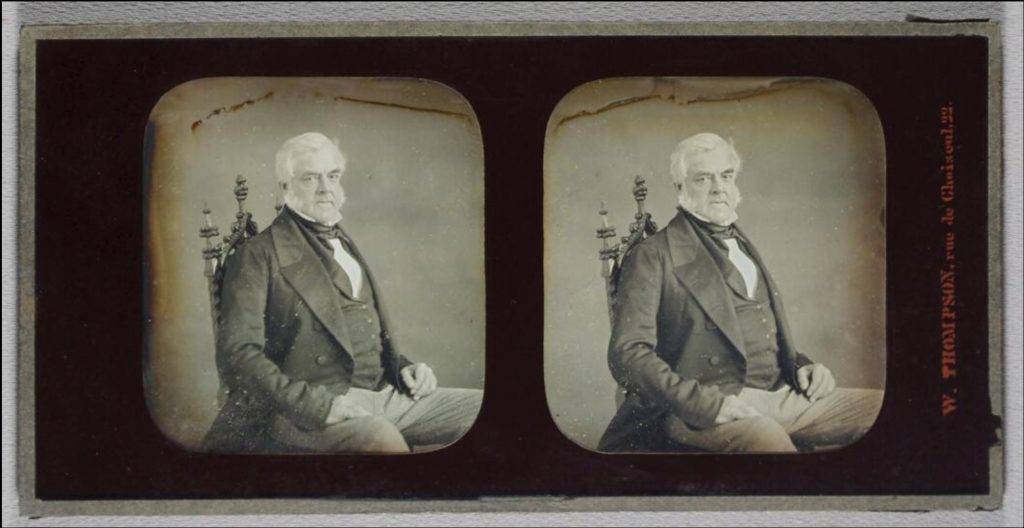
Warren Thompson stereo-daguerreotypes from the National Media Museum (UK) collection 
Warren Thompson stereo-daguerreotypes from the National Media Museum (UK) collection 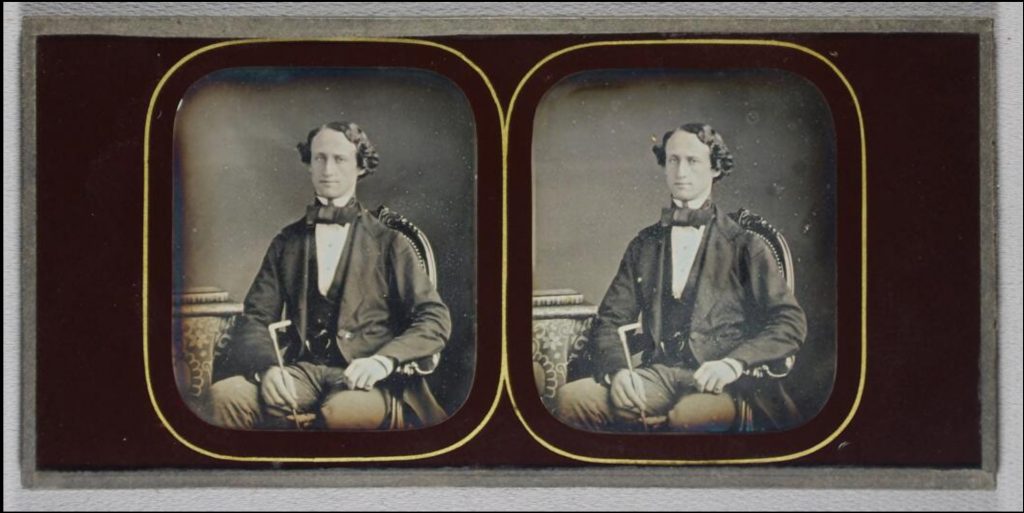
Warren Thompson stereo-daguerreotypes from the National Media Museum (UK) collection 
Warren Thompson stereo-daguerreotypes from the National Media Museum (UK) collection 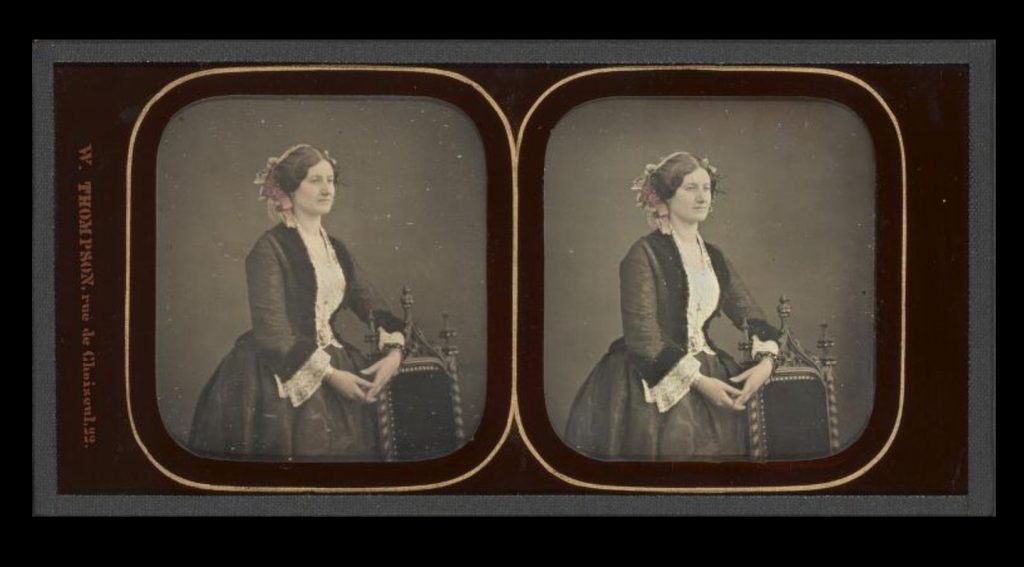
Warren Thompson stereo-daguerreotypes from the Bibliothèque nationale de France collection 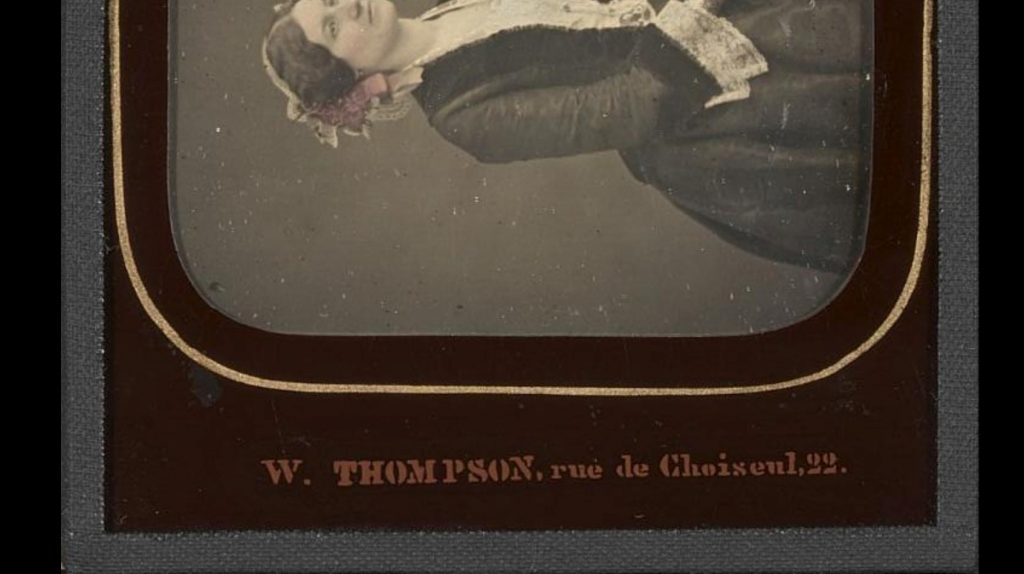
Warren Thompson stereo-daguerreotypes from the Bibliothèque nationale de France collection – detail
The cover glass was under-painted in a style that conforms with what was usually done for stereo-daguerreotypes in Europe at the time; however, Warren Thompson stereo-daguerreotypes from his rue de Choiseul period, preserved in heritage collections, show one or several of the following characteristics.
- Black or brown reverse-painted windows with two golden decorative lines, one around each window, joining as one between the two windows.
- Rust-orange colour reverse-painted name and address of Thompson’s atelier on the right or left side of the windows.
- A stamp or label on the back of the package indicating the name and address of Thompson’s atelier.
Warren Thompson stereo-daguerreotypes with black under-painted windows, without a golden decorative line, all have the rust-orange under-painted name and address. This may suggest that the current glass cover is not original. An analysis of the glass and paint compositions is necessary to confirm this hypothesis.
Conservation treatment of the daguerreotype
Tape removal
The modern sealing tape on the backing board was removed, which allowed access to the original backing board and sealing tape. The tape maintaining the daguerreotype plates in the package was removed to separate the plates from the rest of the mount. It also avoid further damage to the daguerreotype by the contact between the plates’ back and the tape’s adhesive.
The verso of the plates was then fully accessible, where we discovered that one of the plates’ back was silver plated and the other was not, revealing the copper plate. This indicated that the silver layer was added on the copper plate with two different techniques: electroplating and hammering.
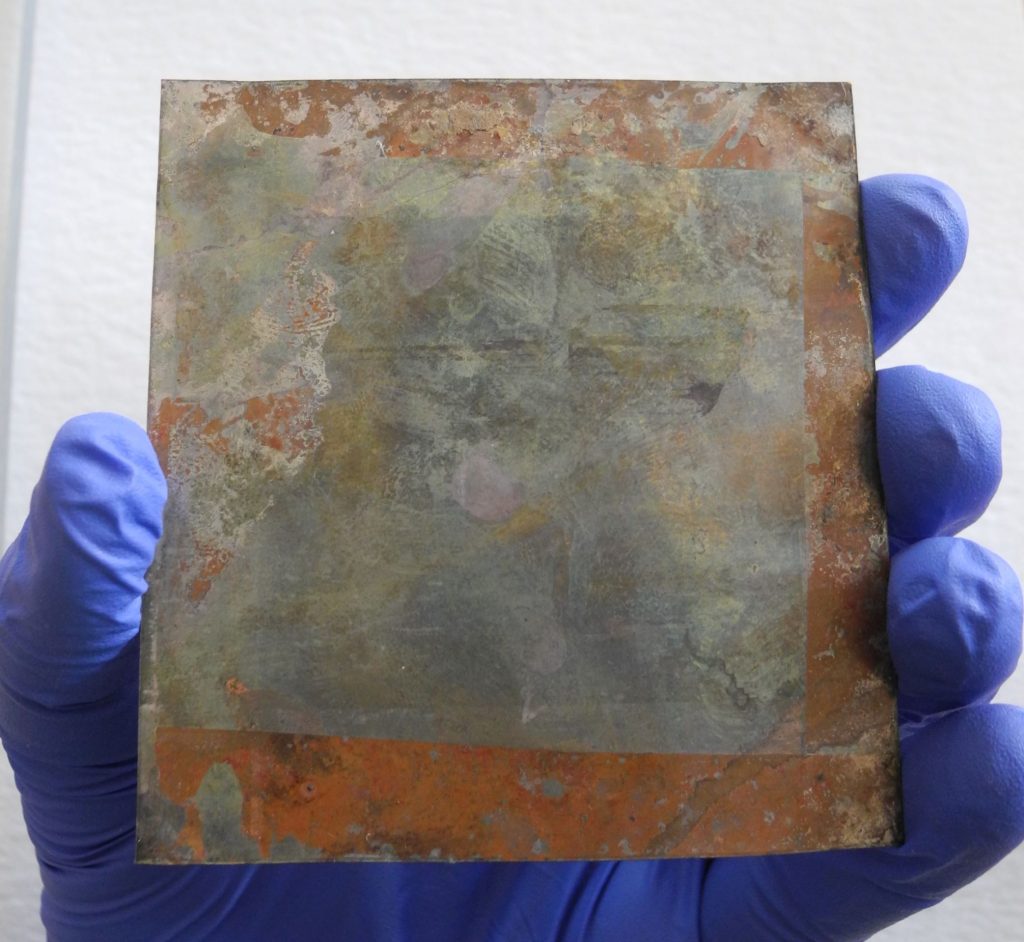
During treatment – verso of left daguerreotype (copper) 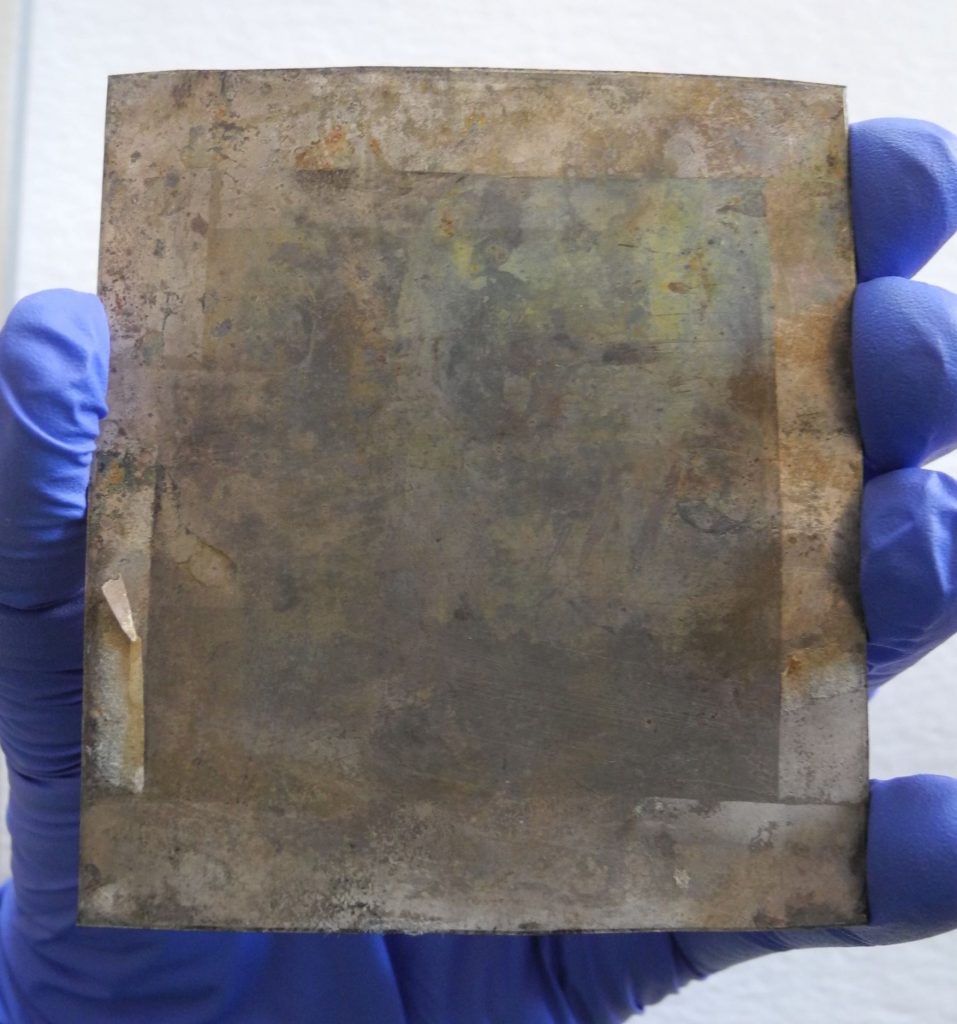
During treatment – verso of right daguerreotype (silver)
New package
Why do daguerreotypes need to be packaged?
Daguerreotypes are very fragile objects which are particularly susceptible to damage from two agents of deteriorations: physical forces and pollutants.
- Physical forces: The silver-mercury particles that form the image lie on the surface of the plate and, as a result, are very sensitive to any physical contact. The lightest friction can remove the particles from the plate and result in irreversible image loss.
- Pollutants: Like all silver objects, the daguerreotype tarnishes when in contact with the pollutants present in the air. Tarnishing is the most common damage found on daguerreotypes and is usually visible in the form of concentric coloured (yellow, magenta, blue) rings of silver sulfides and oxides forming between the edge of the plate and the object’s center.
The creation of an airtight package is thus important to protect the plate surface from contact with other materials and from the pollutants in the air.
The new package was made with conservation materials, where all materials used in direct contact with the daguerreotype are unbuffered conservation materials that pass the Photographic Activity Test (ISO 18916:2007 “Imaging materials — Processed imaging materials — Photographic activity test for enclosure materials”).
It was decided to replace the broken glass cover with a reproduction made with stable conservation materials because the glass cover was unlikely to be original to the object.
Conclusion
The daguerreotype is now in a new package made of stable conservation materials which have been tested and are known not to damage daguerreotypes. The new glass cover and seal provide an airtight package that will slow down or prevent altogether the tarnishing of the daguerreotypes.
Do you have a daguerreotype in your own collection? CLC specializes in the care of all photographic materials and can help you preserve it. Kindly reach out and we can discuss your photographs needs.

After treatment – recto 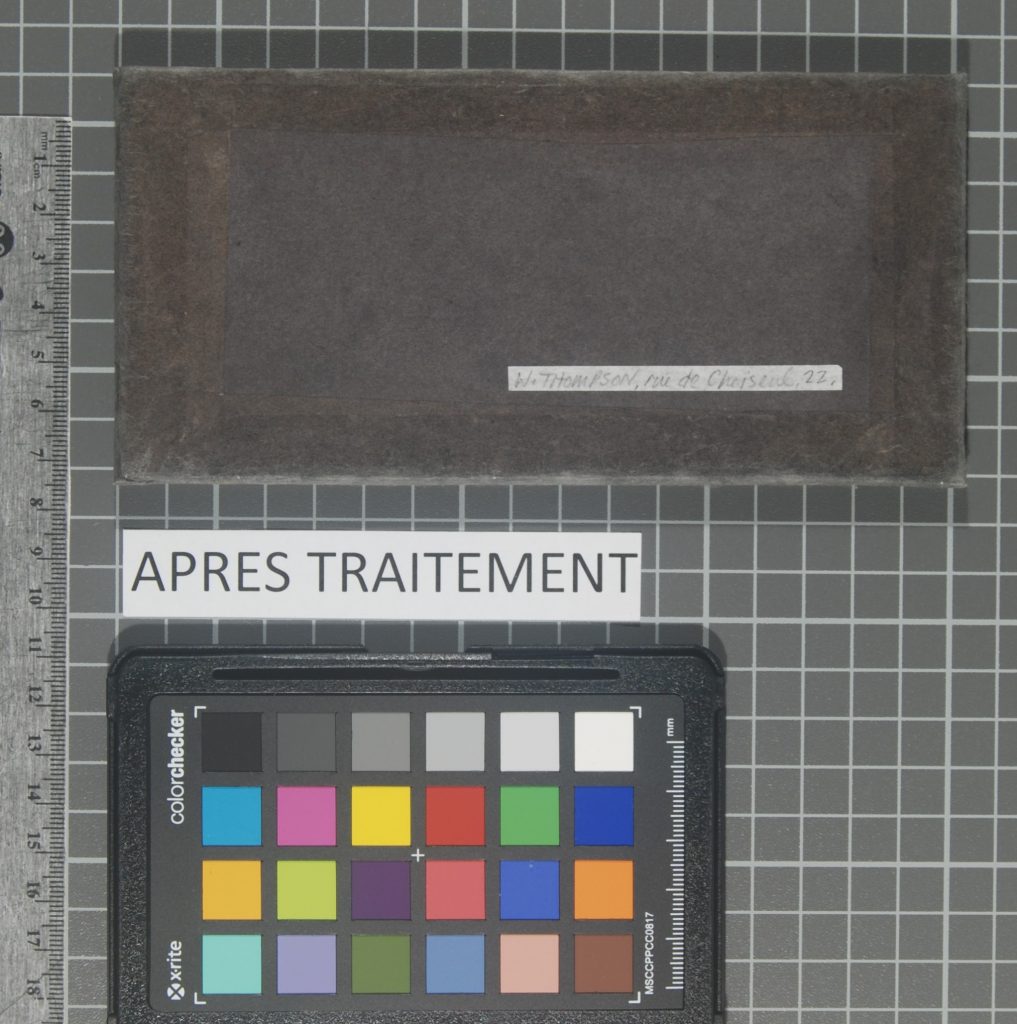
After treatment – verso

